Better Touch Better Business
Contact Sales at XINCHUANG BIO.

Japan's retail industry has been charging plastic shopping bags since July 1, and the charging standards are set by businesses themselves on the basis of relevant laws and regulations. The government hopes to curb the overuse of plastic bags.
——Global Times news today
Introduction
The production of PLA and PBAT in degradable plastics is relatively mature, and the total production capacity is in the forefront; PHA has excellent performance, and with the decrease of cost, it is expected to expand from high-end medical field to larger markets such as packaging and agricultural film in the future. These three kinds of degradable plastics may become the main alternative to traditional plastics.
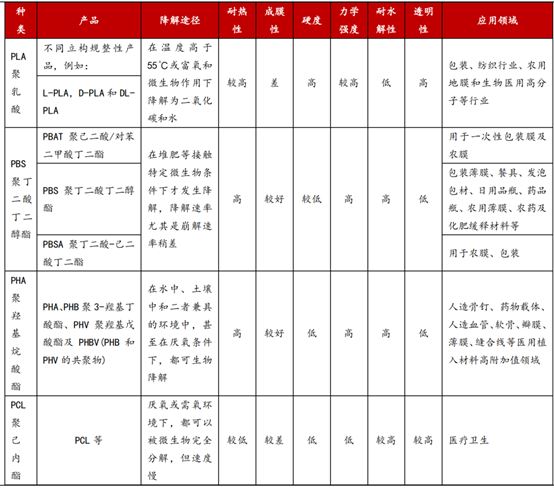
PLA
PLA is one of the most common degradable plastics, which is polymerized from lactic acid. The production process of PLA is pollution-free, and the product can be biodegraded. After use, the PLA can be decomposed into carbon dioxide and water by composting when the temperature is higher than 55 ℃ or oxygen enrichment and microbial action decline, so as to realize the material circulation in the nature, without any impact on the environment.
At present, the production of polylactic acid mainly adopts the ring opening polymerization process of lactide. The lactic acid is dehydrated to form oligomer, then depolymerized to produce lactide, and then the ring opening polymerization is used to prepare polylactic acid.
PLA also has reliable biological safety, biodegradability, good mechanical properties and easy processing. It is widely used in packaging, textile industry, agricultural film and biomedical polymer industry. The disadvantage of PLA is that the degradation conditions are relatively harsh. However, due to the relatively low cost of PLA in biodegradable plastics, the consumption of PLA is in the forefront.
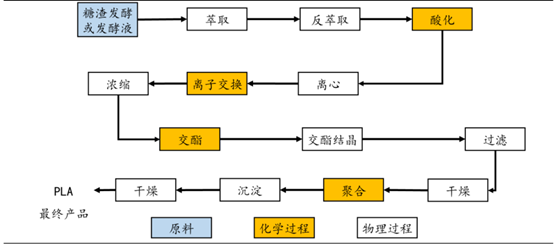
PBS
PBS is synthesized by condensation and polymerization of succinic acid and 1,4-butanediol. The raw material of PBS is petroleum or biological resources fermentation. PBS is easily decomposed into carbon dioxide and water by many microorganisms or enzymes in nature. It has good biocompatibility, bioabsorbability and good heat resistance.
PBS can be used in packaging film, tableware, foam packaging materials, daily necessities bottles, medicine bottles, agricultural films, pesticides and fertilizer slow-release materials and other fields.
Due to the limited raw materials of succinic acid in China, PBAT and PBSA derivatives of PBS are produced in compliance with the requirements. The properties of PBAT and PBSA are basically similar to PBS, but the processing performance is inferior to PBS.
PBAT
PBAT is a kind of thermoplastic degradable plastics, which is usually produced by petrochemical or biological fermentation with aliphatic acid and butanediol as raw materials. It has good ductility, elongation at break, heat resistance and impact properties. PBAT is widely used in disposable packaging film and agricultural film field because of its good film forming performance and easy blowing film.
In addition, PBAT has excellent biodegradability and is one of the most active degradable materials in degradable plastics research and market application.
PHA
PHAs degradable plastics include polyhydroxy fatty acid ester (PHA), poly (3-hydroxybutyrate) (PHB), copolymer of 3-hydroxybutyrate and 3-hydroxyvalerate (PHBV), and copolymer of 3-hydroxybutyrate and 3-hydroxyhexanoate (phbh).
PHAs degradable plastics are the products of bacteria under unbalanced growth conditions. Among all the degradable plastics, PHA has the most special degradation mode. After being used, PHA can be completely degraded into β - hydroxybutyric acid, carbon dioxide and water.
PHAs degradable plastics have high thermal deformation temperature and good biocompatibility, but the processing temperature range is narrow, the thermal stability is poor, the brittleness is large, and the production quality is unstable. It can be used in the fields of disposable goods, medical devices, surgical clothes, packaging bags and compost bags, medical sutures, repair devices, bandages, orthopedic needles, anti adhesion films and stents.
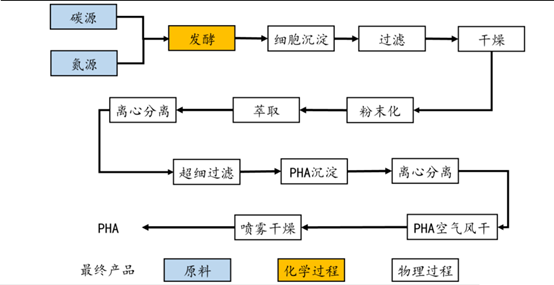
In addition to PLA, PBAT and PHA, starch based plastics (also known as starch compounds or starch mixtures) are the most widely used in Western Europe.
Starch based plastic is a blend of modified starch and degradable polyester (such as PLA / PBAT / PBS / PHA, etc.), which can be completely biodegradable, compostable and pollution-free. Although starch based plastics are cheap, their service life, mechanical properties and printing properties are poor.
A variety of degradable plastics jointly dominate the global degradable plastics market. According to online data, in 2019, the production capacity of starch based plastics will be about 449400 tons, accounting for 38.4% of the world's degradable plastics capacity. PLA and PBAT account for 25.0% and 24.1% respectively, ranking second and third. The structure of degradable plastics in different areas is also different.
In the main consumption areas, starch based plastics are mainly used in Western Europe, while PLA is mainly used in North America, Asia and Oceania.
Western Europe is the region with the largest amount of starch based plastics, mainly because of its early development of degradable plastics. At first, the degradation residue and incomplete molecular degradation of starch based plastics were not found. The United States, as the country that followed the development of degradable plastics, reduced the amount of starch based plastics.
Global production capacity distribution of different types of degradable plastics in 2019
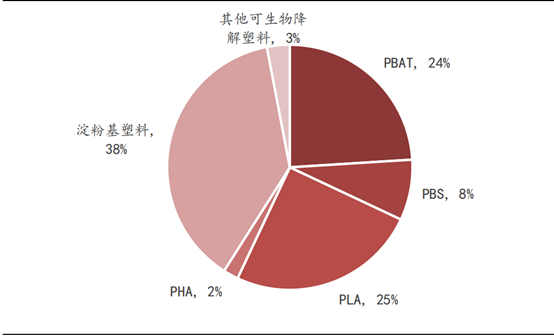
PLA, PBAT and PHA are the main development direction of degradable materials in the future.
PLA and PBAT have a large market share and are the main products of degradable materials replacing traditional plastics at present, mainly because they have better mechanical properties, lower price and cost compared with other degradable materials, and their substitution resistance is small. The main application fields of degradable materials are packaging film and agricultural film, which is due to the substitution of PLA and PBAT for traditional plastics.
PHA is one of the most potential degradable plastics. Because of its excellent mechanical properties and degradation properties, PHA can be completely degraded in vivo.
Compared with PLA and PBAT, the degradation condition of PHA is the most mild. However, due to the high production cost of PHA, the price exceeds most other degradable plastics, so the market share of PHA in degradable plastics market is only 2%, which is mainly used in high value-added fields such as medical devices. With the further reduction of cost and the development of high value-added applications, it will become a cost acceptable biomaterial in multiple application fields.
Distribution of world degradable plastics consumption in 2017 (10000 tons)
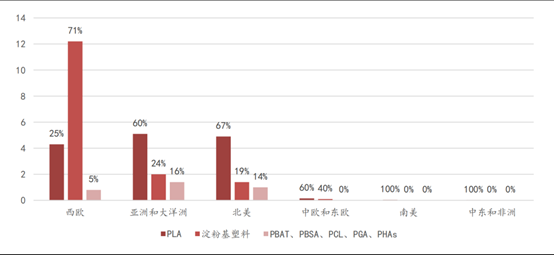
For the applicable fields of degradable plastics, performance is not the bottleneck, but cost is the main factor restricting the marketization of degradable plastics to replace traditional plastics.
Except for starch based plastics, the average price of other degradable plastics is 1.5 ~ 4 times that of traditional plastics. This is mainly because the production process of degradable plastics is more complex, which requires the use of expensive natural biomolecules for polymerization, which virtually increases the production cost.
After the policy driven rapid growth period from 2020 to 2025, China's degradable plastics market may enter a mature period.
Application changes and forecast of degradable plastics in Western Europe from 1996 to 2022 (10000 tons)
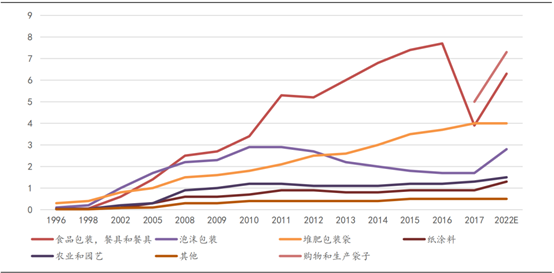
Application changes and forecast of degradable plastics in North America from 1996 to 2022 (10000 tons)
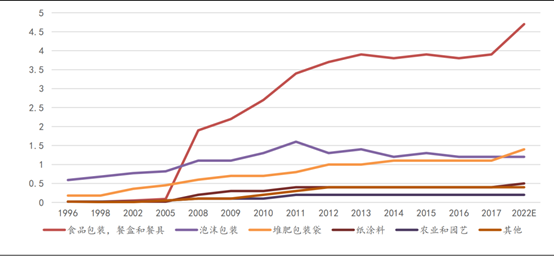
It can be seen from the development history of the application fields of degradable plastics that the industries with rapid growth in demand for degradable plastics are mainly food packaging, tableware and compost packaging bags, and agricultural industries such as compost packaging bags. The average growth rate of degradable plastics substitution reached 12.8% and 10.6% respectively. In other industries, the demand for degradable plastics in Western Europe and North America remained basically unchanged.
Large scale production capacity of degradable plastics in the world in 2019

There are a large number of degradable plastics enterprises in the world, and the types of products produced are also very different, and the market dispersion is high.
At present, the total production capacity of degradable plastics in the world is about 1.362 million tons, but the capacity of single company is small, and the capacity of most companies is less than 50000 tons.
The global market concentration of degradable plastics Cr5 and CR10 are 39% and 59%, respectively, which are in a low level and highly decentralized. In addition, the global degradable plastics market is in the growth stage, and the supply is in short supply. With the implementation of the "ban on plastics", the situation of short supply is first reflected in the price of degradable plastics.
Western Europe
Consumption and forecast of degradable plastics in Western Europe from 1996 to 2022 (10000 tons)
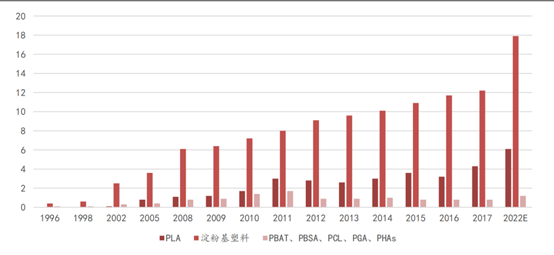
Starch based plastics are the main degradable plastics in Western Europe, followed by PLA. The consumption of other degradable plastics (including PBAT, PBSA, PCL, PGA, PHA, etc.) has been maintained at a low level, accounting for only 5% in 2017. The reason may be mainly due to the high price, which can only be applied to high value-added areas.
According to IHS Markit forecast, the average annual growth rate of degradable plastics consumption in Western Europe will be 8% from 2017 to 2022, including 8% for starch based plastics, 7% for polylactic acid, and 8% for PBAT, PBSA, PCL, PGA and PHAs.
Degradable plastics producers and capacity in Western Europe in 2019


The number of degradable plastics manufacturers in Western Europe is small and the market concentration is high.
The total production capacity of degradable plastics in Western Europe is 463000 tons, accounting for 34.0% of the world. The products of degradable plastics manufacturers in Western Europe mainly include starch based plastics, copolyesters, PLA, cellulose films and PHA.
The Cr5 of degradable plastics market in Western Europe is 88%, the market concentration is very high, and the scale effect is obvious. Among them, novamont was founded in 1989 and is now the world's largest producer of starch based plastics.
North America
Consumption and forecast of degradable plastics in North America from 1996 to 2022 (10000 tons)
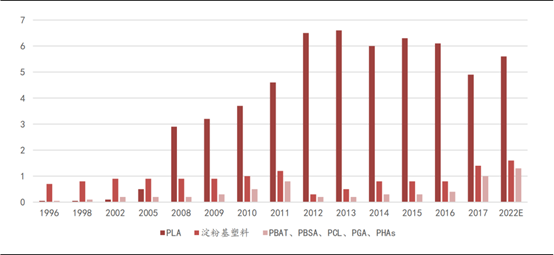
Plastic is the main degradable plastic in North America.
PLA consumption in North America has achieved positive growth from 1996 to 2013, but the growth has stagnated and decreased after 2013, accounting for 67% of the degradable plastics market by 2017, and is expected to reach 56000 tons by 2022.
However, the growth of starch based plastics consumption is relatively unstable, but it will maintain a positive growth after 2012, and is expected to exceed 16000 tons in 2022. The consumption of other degradable plastics (including PBAT, PBSA, PCL, PGA, PHA, etc.) will resume positive growth after 2012, accounting for 14% in 2017.
According to IHS Markit forecast, in 2017-22, the annual average growth rate of degradable plastics consumption in North America will be 3%, including 3% for polylactic acid, 3% for starch based plastics, and 6% for PBAT, PBSA, PCL, PGA and PHAs.
The production capacity of Western Europe is mainly starch based plastics, while that of North America is mainly PLA.
Starch based plastics can not be completely degraded, and biodegradable plastics are the trend
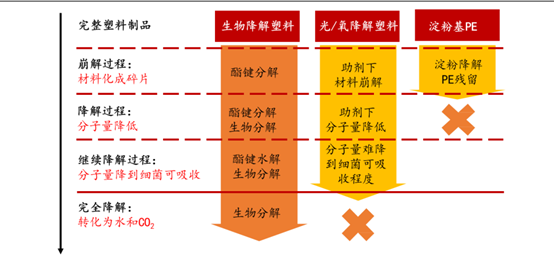
The main reason for this difference in production capacity distribution may be that only starch is degraded in the degradation process of starch based plastics, while PE and other traditional plastic particles are still residual, thus affecting the environment.
The development of degradable plastics in North America is later than that in Western Europe, and the consumption of starch based plastics is not high. Due to the defects of starch based plastics developed in Europe, PLA is focused on.
Degradable plastics manufacturers and capacity in the United States in 2019

The number of degradable plastics manufacturers in the United States is small and the market concentration is high.
The United States has the largest production capacity of degradable plastics except China. The products produced by American degradable plastics manufacturers mainly include PLA, PHA, plant cellulose, PGA, etc. CR2 of degradable plastics market in the United States is 91%, which is at a very high level, and the scale effect is obvious.
Among them, NatureWorks is the largest producer of polylactic acid in the world. It was established by Dow Chemical and Cargill in 1997. NatureWorks built the world's largest polylactic acid production plant in 2001, and is the only enterprise with an annual output of 150000 tons.
China
The production capacity of degradable plastics in China is far greater than the consumption, and the utilization rate of existing production capacity is not high. According to the data of prospective industry research institute, in 2018, the production capacity of degradable plastics in China reached 450000 tons, while the output was only about 135000 tons, and the overall capacity utilization rate was only 30%.
Annual production capacity and output of degradable plastics in China from 2012 to 2019
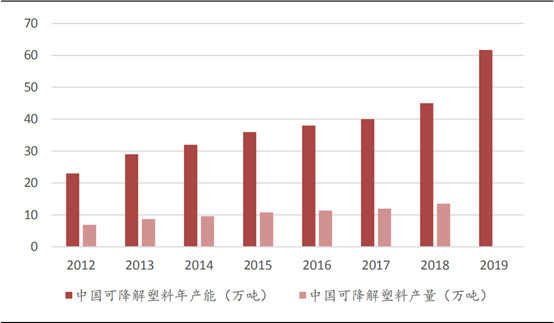
China's degradable plastics production capacity ranks first in the world, with a complete range of products and high market dispersion, but there are not many enterprises that can form large-scale production capacity.
China's degradable plastics market concentration Cr5 and CR10 are 18% and 27%, respectively, which are at a low level and highly decentralized.
At present, China's degradable plastics are mainly exported, and the situation may be reversed in the future. According to IHS data, in 2018, China's net export of degradable plastics was 72000 tons, accounting for 63% of the output of degradable plastics.
Before the promulgation of the ban on plastics, the market scale of degradable plastics in China was small and the demand was small, while the demand in Western Europe was large, which led to the export of degradable plastics in China to the Western European market. With the implementation of the "ban on plastics" all over the country, the situation of net export of degradable plastics in China is expected to change.
With the rapid expansion of China's degradable plastics production capacity, enterprises are scrambling to enter the 100 billion biodegradable plastics market. At present, the capacity of degradable plastics in China is expanding rapidly.

Since December 1, 2020, the "ban on plastic molding" will be officially implemented in Hainan Special Economic Zone. Enterprises and individuals who violate the regulations will be punished by criticism and education, confiscation, fine and revocation of business license. Meanwhile, illegal information will also be included in the credit information sharing platform. We can see that "sky" is really going to change, and the "tuyere" of degradable plastics is coming! Because, the pollution of plastic particles, not only affects the industry and individuals, but also affects the future of all mankind!
Source: company announcement, EIA report, Hua'an Securities Research Institute, prospective industry research institute, Changchun Institute of Applied Chemistry, Chinese Academy of Sciences, government website, IHS Markit
Copyright © 2019 XINCHUANG BIO | All Rights Reserved
Welcome to our website! Please leave your email address for further contact. For more information, plz kindly message: xcbio766@xcbio.com